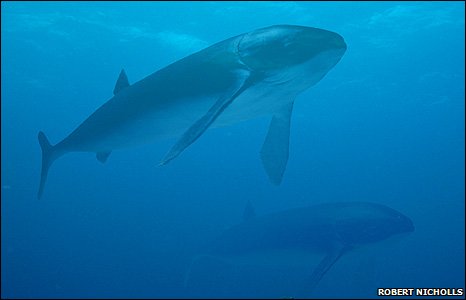Estimating the Size of Leedsichthys
Regarded by many scientists as possibly the largest fish of all time, the filter-feeding teleost Leedsichthys is known from just a few fragmentary remains. With a skeleton made from cartilage, a material that has a poor preservation potential, scientists have struggled for more than a century to try to piece together data on this immense bony fish. The specific name for Leedsichthys is L. problematicus, which reflects the problems palaeontologists have had in interpreting the fossil evidence. After all, it was once suggested that fossils found in eastern England and now ascribed to Leedsichthys belonged to an armoured dinosaur.
Leedsichthys problematicus
A new study carried out by scientists at the University of Bristol in collaboration with the University of Kunming in China have estimated the growth rates of these Jurassic creatures. The research indicates that these animals ranged in size from 12 metres to 16 metres when fully grown. At the top end of this range, Leedsichthys is indeed capable of claiming the title of the largest, bony fish of all time. The animals that occupy a similar niche in today’s marine environment are also of an impressive size, filter feeders such as the Baleen whales, manta rays as well as basking and whale sharks.
There has been a lot of debate about just how big Leedsichthys actually was, to read an earlier article: Leedsichthys Subjected to Fish Shrink Ray.
Professor Jeff Liston a member of the research team that reviewed the known Leedsichthys fossil material stated:
“Leedsichthys skeletons preserve poorly, often only as isolated fragments, so previous size estimates were largely historical arm-waving exercises. We looked at a wide range of specimens, not just the bones but also their internal growth structures – similar to the growth rings in trees – to get some idea about the ages of these animals as well as their estimated sizes.”
The Giant Filter-Feeder Leedsichthys
Picture credit: Robert Nicholls
Cartilaginous Back Bone Preserved
Occasionally, elements of the cartilaginous back bone are preserved. These parts of the skeleton can become mineralised and thus have a better chance of surviving the fossilisation process. Just like in shark species today, the discs that make up the back bone can show preserved internal rings that permit scientists to estimate the age of the animal when it died and how quickly it grew. Using data from documented Leedsichthys fossil finds, including evidence from a recently discovered specimen found near Peterborough (East Anglia, England), the team estimated that an, adult fish of 8-9 metres would be around twenty years of age. Lengths in excess of 16 metres would have been reached when the animal was around 38 years of age.
For models and replicas of prehistoric fish and other ancient creatures: PNSO Age of Dinosaurs Replicas and Scale Models.
Scientists are not sure how long these animals lived, but it has been suggested that these leviathans could leave for forty years or more.
Research Project
The project began in Glasgow with a review of the remains of the giant Jurassic fish Leedsichthys, in conjunction with the excavation of a new specimen of this creature (the Peterborough specimen). Professor Liston, who ran the excavation in Peterborough, wanted to explore an anomaly as before Leedsichthys, most vertebrate suspension feeders did not grow much larger than half a metre in length. It seems sometime around 165 million years ago, the ocean’s ecosystem changed, which permitted these large vertebrates to evolve.
Professor Liston stated:
“The existence of these large suspension-feeding fish at this time is highly significant as it would seem to be clear evidence of a major change in plankton populations in the oceans of Jurassic Earth: a ‘smoking gun’ that something new, widespread and highly edible was around, possibly related to the first appearance of small crustaceans called copepods. This has implications for our understanding of biological productivity in modern oceans, and how that productivity has changed over time.”
The researchers also looked at specialist structures on the gills as a means of how Leedsichthys grew so large.
Professor Liston added:
“One of the truly fascinating aspects of this fish as a suspension feeder, is that it seems to have developed a unique mesh structure on its gills to help it extract plankton as the seawater passed through its mouth. Extremely delicate and rarely-preserved, it resembles the honeycomb pattern in a bee-hive. It functioned like a trawler’s net to trap plankton, and obviously was very effective, given the large sizes this animal achieved. This mesh structure is very different to what we see in today’s suspension-feeding fish and whales. It had a unique way of solving a similar problem.”
A Filter Feeding Giant
Filter feeding seems to have enabled Leedsichthys to grow to a very large size. Its bulk would have made it almost invulnerable to attack, very helpful when you shared the sea with predators such as pliosaurs, plesiosaurs and marine crocodiles.
Leedsichthys
Professor Liston had been involved in a related project reported upon by Everything Dinosaur in 2010. The fossil record is so poor for cartilaginous fish that there was a huge gap in the fossil record from the likes of the Middle Jurassic Leedsichthys to the filter feeders known from the Cenozoic. A discovery of a giant, filter-feeding fish of the Late Cretaceous (Bonnerichthys) helped plug what was a 100 million year gap in the fossil evidence.
To read more about Bonnerichthys: Filter-Feeder from the Western Interior Seaway (Cretaceous).






Leave A Comment